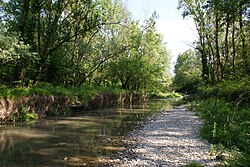| Reggiano | |
 | |
Location .svg/250px-Reggio_Emilia_in_Italy_(2018).svg.png) | |
| State | Italy |
|---|---|
| Region | Emilia Romagna |
| Capital | Reggio Emilia |
| Institutional website | |
Reggiano is a region ofItaly.
To know
Geographical notes
Between its Apennines and the Guastallese With the'Oltrepò Mantua along the Po, the Reggio Po plain stretches between Parma is Modenese around the capital Reggio, with the Via Emilia as a backbone.
Background
After the Roman conquest the territory was centurised and colonized. After the fall of the Roman Empire, it was the center of the vast possessions of the Countess Matilda di Canossa, whose figure was dominant in Italian political events during the struggle between the Empire and the Papacy. Dominating from Reggio at the time of the Municipalities, the area also saw the emergence of small autonomous Lordships in the lower part towards the Po: Correggio, Guastalla, Gualtieri, Novellara, Reggiolo, Rolo. Having entered the Duchy of Modena, it followed its fate until its annexation to the new Italian state, of which Reggio was a fervent supporter; the city boasts the birth of the Tricolore.
Territories and tourist destinations
Urban centers
- Reggio Emilia - The ring road avenues follow the layout of the thirteenth-century walls, then demolished. Its medieval historic center takes you back to the city that once belonged to the Canossa family, and later became a municipality. He served a certain subjection before a Ferrara and then to Modena, in whose Duchy it had a prosperous and peaceful life, but never in the foreground.
- Correggio - Antonio Allegri was a great painter between the fifteenth and sixteenth centuries, but if you don't call him the Correggio, perhaps few know him; also the family that had the Signoria took its name from the city, and was called Da Correggio. This family will give its imprint to the urban layout of the city, with buildings arranged along sinuous streets, and arcades according to the consolidated custom of the Po Valley.
- Montecchio Emilia - Fortified center on the Enza, it was disputed by Parma and Reggio, by the Este and by the Gonzaga, by the Sforza and by the French. The majestic castle remains of its past as a formidable border stronghold.
- Novellara - For a long time it was the capital of an independent state, from 1335 to 1728, and the Gonzagas of a collateral branch were lords of it. Its appearance is an example of a harmonious urban plan, mainly of a Renaissance character.
- Hold it up - It was a fortified outpost of the Municipality of Reggio.
- Scandiano - The Este family gave it as a fief to Matteo Maria Boiardo, their court poet, who wrote theOrlando Furioso; Ariosto also speaks of Scandiano. Nowadays it is known for its wine production White from Scandiano.
How to get
How to get around
What see


- 1 Sanctuary of the Madonna della Ghiara (to Reggio Emilia). From the early seventeenth century, it has frescoes from the Bolognese school. The façade has three-mullioned windows that move the whole, as well as three portals.
- 2 Duomo (to Reggio Emilia). The ancient core is Romanesque; it dates back to the 9th century and was rebuilt in the 13th century. The Romanesque façade in the lower part was covered with marble in the mid-sixteenth century. Inside it preserves works by Spani and Sogari (sepulchral monuments), by Guercino and an antelamic bas-relief.
- 3 Rocca (to Montecchio Emilia). A document by Matilde di Canossa dated 1114 mentions the castle of Montecchio, which was later a possession of the Parmigiani, then of the Este, of the Da Correggio, of the Torelli, of the Visconti, finally of the Este in a definitive way. In the course of its history it was demolished and rebuilt. It was always a bulwark opposed to the opposite castle of Montechiarugolo dei Torelli, in the Parma area. It is located on the edge of the historic center; it has an irregular plan, due to the interventions that have taken place over the centuries. The oldest part, that of the Matildic period, is that of the clock
- 4 Rocca (to Novellara). The Gonzagas began it at the end of the fourteenth century, and brought it to completion in the fifteenth-sixteenth centuries. It houses a small art gallery of works from the Emilian school, and is also the seat of the Town Hall and the Gonzaga Museum.
- Rocca (to Hold it up). It was built in the thirteenth century, and in the fourteenth it was further fortified. It has four corner towers joined to the keep and crenellated. Its interior houses offices.
- 5 Rocca (to Scandiano). In the 15th century, the Boiardo family transformed a fortress from 1262 into a noble residence; later it belonged to the Thiene; now it is from the Military Academy of Modena. The detached frescoes by Niccolò dell'Abate are preserved in the Galleria Estense in Modena.
- 6 Palace of the Princes (to Correggio). It is a sixteenth-century construction. It has a porticoed courtyard and carved portal. It is now home to the municipal library and the Civic Museum, which houses seventeenth-century Flemish school tapestries and a Head of Christ of Mantegna.
Itineraries
- In the lands of Matilda - The itinerary runs through a large part of the territory that was, at the turn of the twelfth century, governed and lived by the great countess Matilde di Canossa.
